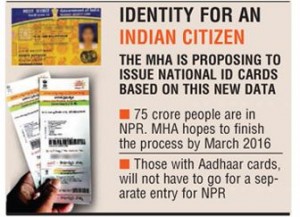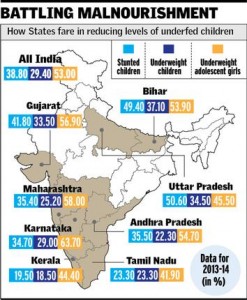IASbaba's Daily Current Affairs Analysis, National, UPSC
Archives
IASbaba’s Daily Current Affairs- 06th July, 2015
NATIONAL
Aadhaar data, NPR to be merged for National IDs
- The National Population Register, envisioned during the Atal Behari Vajpayee
 government in 2002, is all set to be the final word on the identity of Indian citizens.
government in 2002, is all set to be the final word on the identity of Indian citizens. - The Union home ministry is now fast-tracking the merger of Aadhaar with NPR, which it believes will be the final authentic national database on the basis of which National Identity Cards for all citizens above 18 can be issued.
Why is National ID Necessary?
- From weeding out wrong persons holding ration cards and LPG subsidy to illegal migrants and terror suspects, the biometric details and iris images along with personal data will be readily available.
- Those with Aadhaar, will not have to go for a separate entry in NPR.
How is it related to security of the country?
- So far, 75 crore people have been enrolled in the NPR, and the home ministry hopes to complete the entire enrolment process by March 2016.
- The MHA is looking at NPR data to tackle rising internal security threats from organised crime, money-laundering, terrorism and illegal migration.
Connecting the dots
- What are the salient Features of National Identification Authority of India Bill?
- Write a note on National Population Register and explain its Advantages
Dramatic drop in number of Underfed children: UNICEF
Despite remarkable improvements in child nutrition over the last decade in India, Some States, Such as Gujarat, Have struggled to reduce the numbers of underweight and stunted children.
What RSOC says?
- Tamil Nadu, West Bengal, Uttarakhand and Tripura are the only States which
 have reduced the proportion of underweight adolescent girls according to the findings of the Rapid Survey on Children (RSOC), a nation-wide sample survey of over one lakh households conducted by the UNICEF.
have reduced the proportion of underweight adolescent girls according to the findings of the Rapid Survey on Children (RSOC), a nation-wide sample survey of over one lakh households conducted by the UNICEF. - Almost all States have performed poorly in reducing the number of underweight adolescent girls.
What is the status of States according to UNICEF?
- Uttar Pradesh still has the highest levels of child stunting, with over 50 per cent of the children under the age of five underdeveloped, meaning that their height is more than two standard deviations less than the expected height for their age for that population.
- Jharkhand, meanwhile, has the highest number of underweight children under the age of five, meaning their weight for age is more than two standard deviations less than what would be expected.
- Kerala remains the best performing State in the number of child stunting cases, while Manipur and Mizoram have the lowest numbers of underweight children.
- Delhi and Mizoram reduced child stunting at the fastest rate between 2004-05 — when the last official National Family Health Survey (NFHS-3) was conducted — and 2013-14.
- While Madhya Pradesh and Bihar still have high levels of underweight children, both States reduced these numbers at fast rates along with Himachal Pradesh.
Connecting the Dots
- Why there is a sudden child stunt drop in India In spite of many welfare schemes?
- Why only some States have made remarkable progress in battling child malnourishment, others have made little progress despite a decade of high growth?














